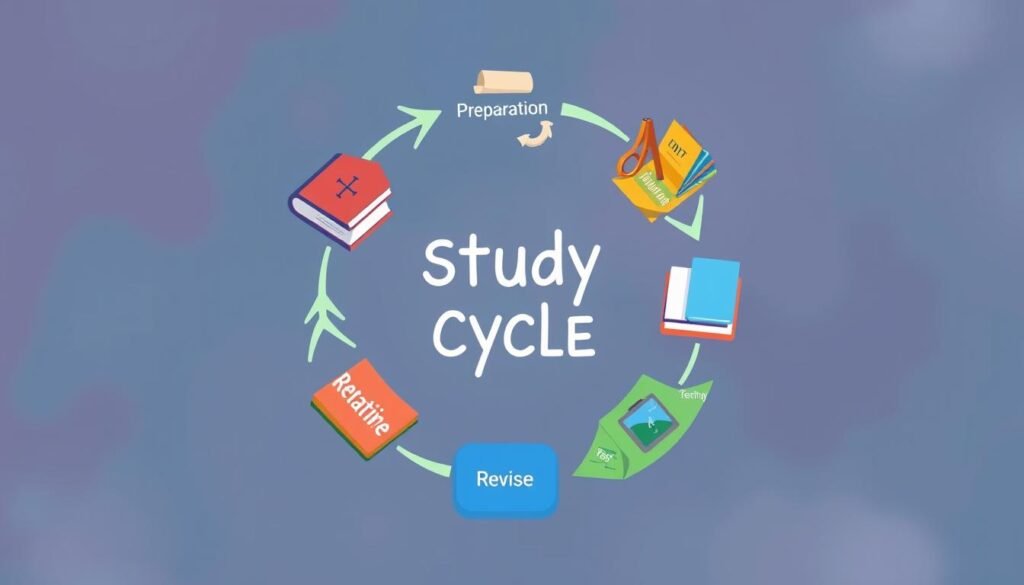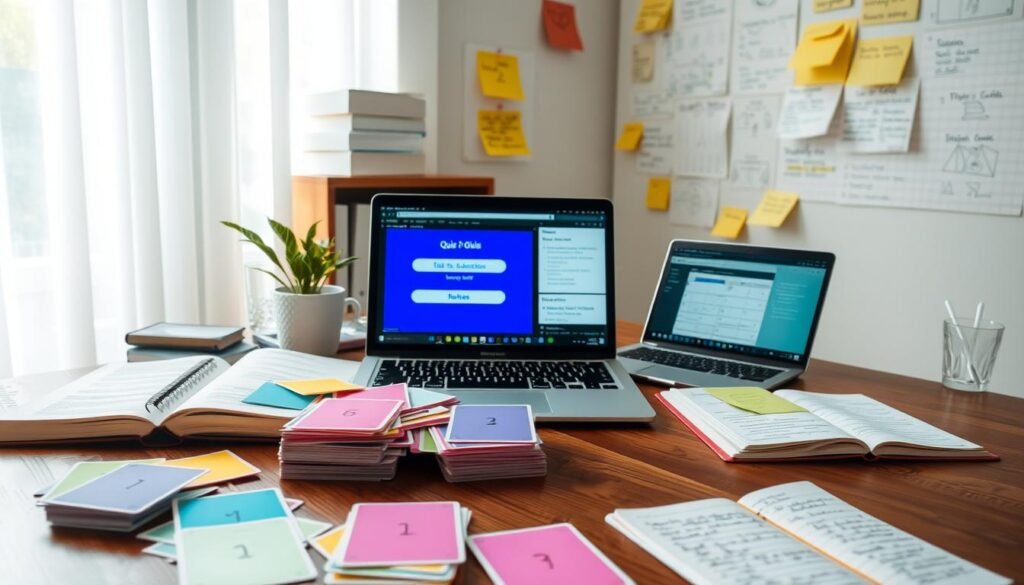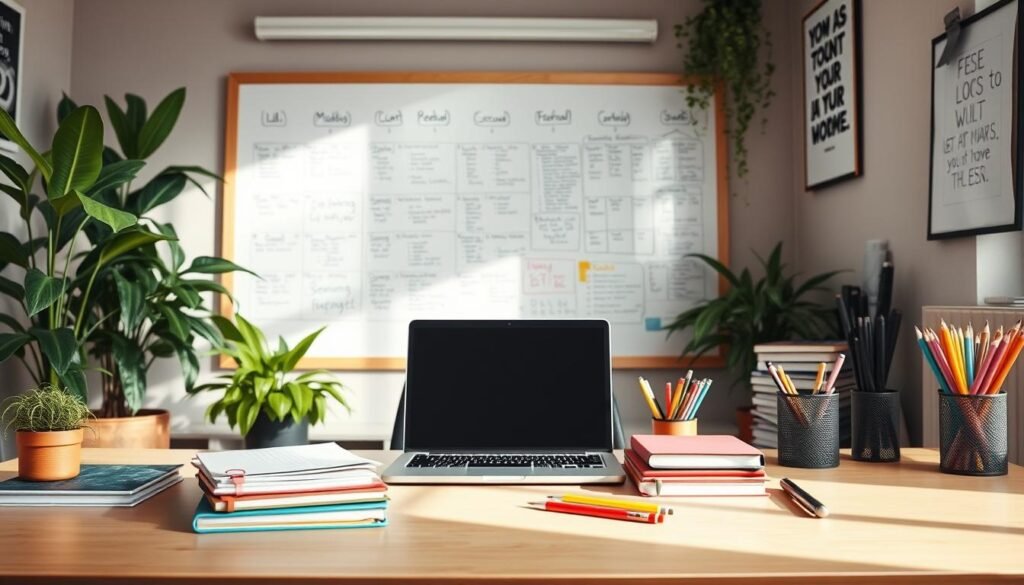Many students find their high school study habits don’t work in college. Professors are less involved, classes are bigger, and exams are worth more. Reading and classes are also more intense. This guide offers tips on how to study effectively and efficiently.
Key Takeaways : Make Education More Efficient
- Active engagement is key – simply reading and re-reading texts or notes is not enough.
- Understanding the study cycle, including previewing, attending class, reviewing, studying, and checking your understanding, is important.
- Spacing out your studying over several short periods of time over several days and weeks is more effective than cramming.
- Multitasking reduces productivity and learning, so eliminate distractions for focused study.
- Retrieval practice and interleaving concepts can significantly boost learning and memory.
Active Learning Strategies for Efficient Studying
Just reading and re-reading isn’t enough. This passive way can cause you to forget quickly. To really learn and keep the knowledge, you must actively engage with the content.
Reading is Not Enough – Engage with the Material
Active engagement means making sense of the text. It’s about linking it to lectures and making examples. It also means controlling your own learning. Good active learning strategies include:
- Creating study guides by topic
- Formulating questions and problems, then writing complete answers
- Becoming a “teacher” and explaining concepts in your own words
- Deriving examples that relate to your own experiences
- Creating concept maps or diagrams
- Developing symbols that represent key concepts
Create Study Guides, Teach Concepts, and Practice Problems
In non-technical classes, focus on the big ideas. You should be able to explain, contrast, and review them. For technical classes, solving practice problems is key. Explain each step and your reasoning. This way, you’ll understand and remember better.
“Students felt they learned more through traditional lectures, but in reality, they learned more when engaged in active-learning strategies.”
Studies show active learning beats passive lecturing. Use these methods to study smarter, not just harder.
Understanding the Study Cycle

The study cycle is a powerful tool for students to improve their learning and get better grades. It was created by Frank Christ at Louisiana State University’s Center for Academic Success. This five-step system helps students study in a structured way, working well in different classes and learning settings.
The study cycle focuses on five main steps: preview, attend, review, study, and check. These steps help students fully understand and remember the material. This leads to a deeper understanding and better retention of information.
- Preview the material before class by reviewing the syllabus, reading assigned texts, or exploring relevant resources. This helps students get familiar with the content and know what to focus on.
- Attend the class, actively listening and participating to reinforce the concepts presented.
- Review the material shortly after the class, consolidating the information and identifying any gaps in understanding.
- Study the material through focused, distributed practice sessions, engaging with the content in various ways, such as creating study guides, teaching concepts to others, or solving practice problems.
- Check your understanding by regularly assessing your mastery of the material, through self-testing or discussions with peers.
Using the study cycle is especially helpful for students moving from high school to college or taking online courses. By following this cycle, students can understand the material better, avoid common study mistakes, and learn more efficiently.
| Step | Description | Benefits |
|---|---|---|
| Preview | Review the syllabus, assigned readings, and course materials before class. | Familiarizes students with the content, identifies areas of focus, and enhances engagement during class. |
| Attend | Actively participate in the class, listen, and engage with the material. | Reinforces concepts, provides opportunities for clarification, and promotes deeper understanding. |
| Review | Revisit the material shortly after the class, consolidating the information and identifying any gaps. | Helps solidify the material in memory and prepares students for more effective studying. |
| Study | Engage in focused, distributed practice sessions, creating study guides, teaching concepts, and solving problems. | Promotes deeper learning, long-term retention, and the ability to apply the knowledge. |
| Check | Regularly assess your understanding through self-testing, discussions with peers, or other assessment methods. | Identifies areas of strength and weakness, allowing for targeted improvement and adjustments to study habits. |
By adopting the study cycle, students can reach their full educational potential and achieve better grades. The key is to stick to the cycle and keep improving their study methods as needed.
The Power of Spaced Practice

Spaced practice, or “distributed practice,” is a top learning strategy. It involves studying in short, spaced-out sessions over days and weeks. This method is much better for keeping information in your long-term memory than long, single study sessions.
Even if you study the same amount of time, spaced practice makes learning deeper. You’ll remember what you learn for a long time.
Space Out Your Study Sessions for Long-Term Retention
Long study sessions can make you lose focus and remember less. But, breaking your study into short, intense sessions helps you stay sharp. You’ll remember more because of it.
Studies show that spaced repetition is better than studying all at once. It keeps your mind fresh and focused.
Short, Intense Study Sessions are More Effective
Not all study time is the same. Short, intense sessions of 30-45 minutes are better than long, unfocused ones. These sessions help you work more efficiently with less effort wasted.
Trying to study for hours can distract you. Instead, use focused 45-minute blocks with breaks. This keeps your mind sharp and helps you learn better.
Learning changes how our brain’s neurons connect. Long study sessions can make you tired, affecting how you learn and remember. Spaced practice, on the other hand, helps you learn and remember better over time.
“Spacing out your study sessions over short periods of time across several days and weeks helps you focus, stay on top of your work, and retain information better.”
Make Education More Efficient with Retrieval Practice

For decades, research has shown that retrieval practice boosts learning and memory. It involves actively recalling information instead of just re-reading it. This method has been proven to improve grades in many subjects and at different levels.
Self-Testing Boosts Learning and Memory
One study showed that students who tested themselves did better than those who just re-read. The Feynman Technique, where you explain concepts in your own words, is especially good for long-term memory. When studying for a test, try to do as many practice questions as you can from different sources.
Retrieval practice can even help students go from a C to an A grade. Almost 100 years of research backs up its effectiveness. It’s more powerful than lecturing, re-reading, or note-taking.
Using retrieval practice makes learning stick longer. It improves complex thinking, application skills, and knowledge organization. It works well for all kinds of students, including those in special education and gifted classrooms.
“Retrieval practice is considered one of the most effective evidence-based learning strategies.”
Adding retrieval practice to your study routine can be easy. You can use clickers or colored index cards for self-testing. Feedback is key, especially with multiple-choice questions. But, other methods like paper-and-pencil quizzes can work too.
By making retrieval practice a part of your study routine, you can learn more efficiently. This will help you do better in school and remember things longer.
Interleave Your Practice for Better Learning

Reading and re-reading material alone is not enough to master a subject. Active, interleaved practice is key to deep understanding and long-term retention.
Mix Up Concepts and Topics for Deeper Understanding
Interleaving your practice mixes different concepts and topics. This method forces your brain to connect ideas and recognize patterns. It leads to a more complete understanding of the material.
Studies show interleaving boosts long-term skill and retention. It challenges students to process more information and connect concepts. This improves problem-solving and deep learning.
Using various concepts in your learning refreshes your memory and expands your understanding. Interleaving engages you with diverse skills in projects and activities.
Try station-based learning to mix teacher-led instruction, online learning, and group activities. This method keeps you switching between different concepts and skills. It increases long-term proficiency.
Interleaving might seem harder than focusing on one skill at a time. But, its benefits like better memory and problem-solving skills are worth it. It’s a powerful way to learn.
Visualize Information for Improved Memory

Visualisation is key for better studying and learning. Using diagrams, graphs, and mind maps can greatly improve your memory. It helps you understand the material better.
Studies prove that using memory tricks, like visualising information, leads to better results. It makes learning stick in your mind. This way, you can recall and use what you’ve learned more easily.
Using more than one sense, like sight and touch, also boosts memory. Drawing diagrams or making flashcards with pictures works better than just reading. It’s more engaging and effective.
- Make mind maps, flowcharts, or other visual aids to show important concepts and how they connect.
- Turn hard ideas into simple, easy-to-remember images or symbols.
- Try the “memory palace” method. Imagine a place you know well to store your learning.
- Use mnemonics, like rhymes or acronyms, to make information stick in your mind.
Adding these visual and spatial methods to your study routine can really help. It uses your brain’s natural ability for visual and spatial memory. This leads to better memory improvement and keeping information for longer. So, use the power of visualize information to enhance your learning.
Eliminate Distractions for Focused Study

To study smarter, not harder, you need to get rid of distractions. Social media, web browsing, gaming, and texting can really hurt your study time. Studies show that multitasking makes learning take longer and lowers its quality.
By removing distractions, you can dive deep into your studies. If you don’t need your computer, don’t use it. Use apps to limit your time on certain websites. Turn off your phone or put it in another room to avoid constant checks.
Multitasking Reduces Productivity and Learning
Dr. Larry Rosen found that students get distracted for about 5 minutes out of every 15 for studying, mainly because of texting and social media. Multitasking hurts productivity and learning. Taking breaks can boost productivity and help you remember things better, with a 10-minute break for every 45–50 minutes of work.
To improve your focus and productivity, try these tips:
- Write down your tasks and schedule in a paper planner to boost concentration and memory.
- Listen to classical or instrumental music to help you concentrate, as music with lyrics might be too distracting.
- Use a reward system to stay motivated and focused.
- Get 7-9 hours of sleep each night to reduce distractions and improve focus.
- Take regular breaks during study sessions, working in short one-hour chunks followed by breaks.
- Stay active, like taking a fitness class or going for a run, to help you stay focused while studying.
- Set SMART goals (specific, measurable, achievable, realistic, timely) to stay on track and motivated.
- Use self-regulation techniques, like moving to a quieter spot, to manage distractions.
- Create an accountability system with friends or roommates to stay focused and avoid distractions during study sessions.
- Limit or restrict unnecessary technology use during study and class times to minimize distractions and improve concentration.
By using these strategies to eliminate distractions and focus on your studies, you can boost your productivity and learning outcomes.
Also Read : Revolutionizing Learning: The Role Of Technology In Modern Education
Conclusion
Using the 10 tips from this article can make your education more efficient. You can boost your learning by using active learning strategies. This includes understanding the study cycle and practicing spaced and retrieval-based studying.
Interleaving your practice, visualizing information, and avoiding distractions are also key. By doing these, you can study smarter, not harder and get better academic success. It’s important to try different methods to see what works best for you.
Sticking to these proven strategies will help you do well in school and beyond. The efficient education tips from this article can help you deal with challenges like the COVID-19 Pandemic. They empower you to reach your full potential and help your community grow.
Start using the study smarter, not harder approach to unlock your path to success. With hard work and a flexible mindset, you can overcome any obstacle and excel in your studies.
FAQs
Q: How can I improve education in my school?
A: To improve education in your school, consider implementing differentiated instruction strategies that cater to the diverse needs of learners. This can also involve investing in technology that can help facilitate personalized learning experiences.
Q: What role does parental involvement play in student learning?
A: Parental involvement is crucial as it encourages students to engage more actively in their education. Research shows that students with supportive parents tend to perform better and have a more positive attitude towards their school system.
Q: How can educators evaluate the effectiveness of their teaching methods?
A: Educators can evaluate the effectiveness of their teaching methods through continuous assessment strategies, including formative evaluations, to gauge student understanding and adapt their approaches accordingly.
Q: What initiatives can schools implement to personalize learning?
A: Schools can implement initiatives that include technology integration, such as using laptops and educational software that tailor lessons to meet the individual needs of each student, thereby improving the quality of education.
Q: How can technology help improve student learning?
A: Technology can help improve student learning by providing interactive tools that engage learners and facilitate personalized learning experiences. This can also include online resources and apps that enable students to learn at their own pace.
Q: What are some effective classroom strategies to address diverse learner needs?
A: Effective classroom strategies include using differentiated instruction, allowing for flexible grouping, and employing varied assessment methods to ensure all students’ needs are met and that they can succeed.
Q: How can schools assess the quality of education they provide?
A: Schools can assess the quality of education through comprehensive evaluations that analyze student performance data, feedback from educators, and satisfaction surveys from parents and students to identify areas that need improvement.
Q: What impact do school interventions have on student outcomes?
A: School interventions can significantly impact student outcomes by providing targeted support for those who struggle, thus enabling them to catch up with their peers and improve overall educational achievement.
Q: How can the school system support low- and middle-income countries in improving education?
A: The school system can support low- and middle-income countries by investing in infrastructure, training educators, and developing policies that promote access to quality education and resources for all students.
Source Links
- https://learningcenter.unc.edu/tips-and-tools/studying-101-study-smarter-not-harder/
- https://www.snexplores.org/article/top-10-tips-study-smarter-not-longer-study-skills
- https://news.harvard.edu/gazette/story/2019/09/study-shows-that-students-learn-more-when-taking-part-in-classrooms-that-employ-active-learning-strategies/

